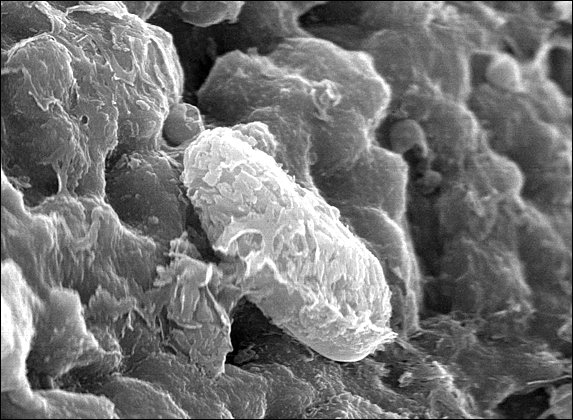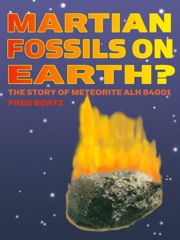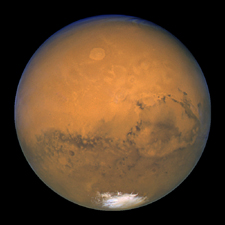


 Click here to shop for the 1997 edition.
Click here to shop for the 1997 edition.

The year 2004 began with some very exciting events on Mars, with the safe arrival of the rover Spirit. As I write this, another rover, Opportunity, is due to arrive in about ten days. To visit the Mars Rover website, click the picture of Mars below, but first copy the URL (http://www.fredbortz.com/MFOEupdate.htm) of this page and remember to come back soon.

Meanwhile, back on Earth, scientists have found another piece of Mars that fell in Antarctica. This is from NASA news release 04-232, dated July 20, 2004.
"The new specimen was found by a field party from the U.S.
Antarctic Search for Meteorites program (ANSMET) on Dec. 15,
2003, on an ice field in the Miller Range of the Transantarctic
Mountains, roughly 750 km (466 miles) from the South Pole. This
715.2-gram (1.6-pound) black rock, officially designated MIL
03346, was one of 1358 meteorites collected by ANSMET during
the 2003-2004 austral summer.
"Discovery of this meteorite occurred during the second full
field season of a cooperative effort funded by NASA and
supported by the National Science Foundation (NSF) to enhance
recovery of rare meteorite types in Antarctica, in the hopes
new martian samples would be found.
"Scientists at the Smithsonian Institution's National Museum of
Natural History involved in classification of Antarctic finds
said the mineralogy, texture and the oxidized nature of the
rock are unmistakably martian. The new specimen is the seventh
recognized member of a group of martian meteorites called the
nakhlites, named after the first known specimen that fell in
Nakhla, Egypt, in 1911."
When Martian Fossils on Earth? came in out 1997, scientists knew many questions were still to be answered and many new ones would come up. That's why the book has a chapter called "Do All Scientists Agree With These Findings?"
The answer to that question was -- and still is -- no, but the disagreement has begun to take a more definite shape since then. I'm thinking about writing a revised edition, so I am collecting new questions and information.
For the latest news on that disagreement, visit the NASA Mars Meteorite Home Page. You'll probably do a lot of exploring, but, again, don't forget to back here. Before clicking, copy the URL for this page:
http://www.fredbortz.com/MFOEupdate.htm
I like to view this particular scientific argument as a tug of war between two groups of very determined people. Although scientific arguments are supposed to be about science alone, scientists are human beings, which means they have biases. As long as a question is not settled, a particular scientist's bias often influences which research he or she finds most persuasive. Bias always colors a person's interpretation of evidence, though scientists are usually better than most people at seeing the other side of the issue.
In this particular tug of war, the stakes are high. Who wouldn't want credit for being the part of first group to find evidence of life on another world? Thus you may discover some books and articles that seem to go overboard in saying that the structures and chemicals discovered in Meteorite ALH84001 are -- or are not -- fossils.
The people on one side of this tug of war are those who first announced that the evidence strongly suggested ancient life on Mars. On the other side are people who are fulfilling an important scientific task by attempting to discredit that interpretation. Both sides agree that, in the words of Carl Sagan, "Extraordinary claims requires extraordinary evidence." The "Martian Fossils" side believes their evidence is powerful, if not yet extraordinary. The other side believes that processes other than life could have plausibly created the "flecks and specks," as I call them in the book.
In the first three years after Martian Fossils on Earth? was published, the no-fossils side seemed to be winning the battle. They showed that the polycyclic aromatic hydrocarbons (PAHs) that suggested life could have come from sources on Earth or might have formed from ordinary non-living chemistry on Mars. When they looked closely at the magnetite crystals that resembled the ones made by bacteria on Earth, they saw details that suggested a different, non-living way for them to form.The prevailing opinion had clearly shifted to their opposition, but the Martian Fossil side had good reason not to give up. They went back to their laboratories and asked new questions. Meanwhile, in 2000, images from the Mars Global Surveyor satellite made people wonder if ALH84001 really did have fossils. They showed layers of sedimentary rock that appeared to have been created by a large ancient Martian lake, a likely place for bacterial life to thrive. Then on February 27, 2001, two groups of scientists published new results about magnetite crystals in Meteorite ALH84001 in the Proceedings of the National Academy of Science of the United States of America.
Both groups had looked closely at the those crystals. One group examined the purity and crystal structure. They said the crystals were "both chemically and physically identical" to magnetite that "magnetotactic" bacteria make on Earth, which they use to guide themselves in the Earth's magnetic field.
The other group studied their shapes, sizes, and spacing of the magnetite crystals. They discovered that the crystals -- each a little bar magnet -- formed chains of very similar pieces. They also saw what appeared to be "a halo that is a possible remnant of a membrane" around the chains. If the magnetite crystals were formed through non-living processes, their magnetism would have made them clump together. The chains and the halo pointed strongly at life.
One conclusion was different from the first observations in 1996. The second group didn't think the bacteria lived in ALH84001. Rather, they think that dead bacteria washed into cracks in the rock. As Martian Fossils on Earth? states, those cracks probably formed at the time of the impact of a large meteorite on Mars 3.9 billion years ago. The researchers state, "Although it is unlikely that magnetotactic bacteria were ever alive in ALH84001, decomposed remains of such organisms could have deposited in cracks in the rock while it was still on the surface of Mars."
The story took another interesting turn on March 16, 2001, when a group of planetary science researchers published new findings from their study of information from Mars Global surveyor. They concluded that very early in the history of Mars, a collossal volcanic eruption created a raised region about as large as the United States and Canada combined called the Tharsis Rise, surrounded by a trough about as far below it as Mount Everest is above sea level on Earth. The same event caused a feature called the Arabia Bulge on the opposite side of Mars.
That massive eruption, they said, could have released enough water and carbon dioxide to cause a large "greenhouse effect," creating a very long period where the planet was warm enough to have liquid water. They aren't saying that life definitely arose during that period, but the conditions were right for life on Mars.
Meanwhile, the debate over fossil bacteria has shifted to Earth. Dr. William Schopf, one of the leading skeptics about the "Martian fossils," claims to have found bacterial fossils in 3.5 billion-year-old rock from Western Australia, but now faces scientists who are skeptical of his work. That's not surprising. Scientific results gain acceptance by facing criticism and surviving. It will be interesting to watch how this argument turns out. You can read about it in a New York Times article from March 12, 2002.
More about the small size of the features found in ALH84001: Read this article from September 17, 2003 issue of the on-line Astrobiology Magazine before the new landers reach Mars at the end of the year.
Bookmark this page to follow future developments! I hope that you, like those researchers, always follow your questions.
Scientifically yours,
[Dr. Fred's Office |What's
New? | Meet Dr. Fred! |
Books By Dr. Fred |
Ask Dr. Fred |
School Visits | Dr. Fred's
Certified Children's Books |
Science Project Discussion Area | Links To
Fellow Writers ]
Dr. Fred logo and art may not be reproduced in any form for commercial or educational use without the written permission of its owner, Alfred B. Bortz.